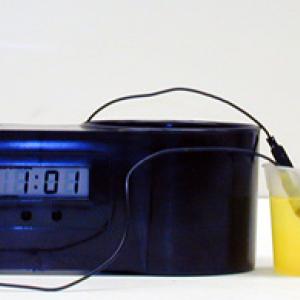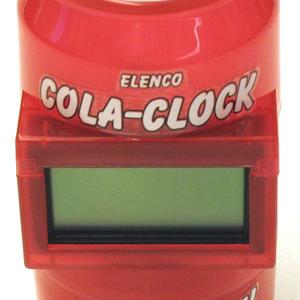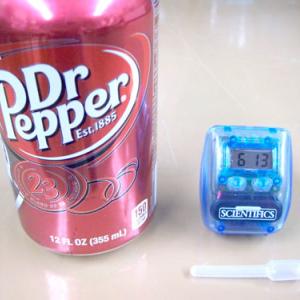College of Liberal Arts & Sciences
5E40.27 - Potato Clock
This unit is designed to show that a battery may be made from a acidic fluid or fluid matrix and two electrodes of different materials, in this case copper and zinc. These clocks runs on approximately 2 to 3 volts so the unit has two cells connected in series. Usually I use two small beakers filled with Mountain Dew. Insert a copper and zinc electrode into each beaker making sure that electrodes do not touch each other. The clock should start immediately and can then be set to the correct time. The two beakers may be replaced with two potatoes, two lemons, two potted plants, and a host of other possibilities. In the fluid matrix situations ( fruits and plants ) the electrodes may have to be moved to within 1/2 inch of each other to maintain the needed conductivity.
- James Stankevitz, Roy Coleman, "A Curious Clock", TPT, Vol. 23, # 4, Apr. 1985, p. 242 - 244.
- Thomas B. Greenslade Jr., "Student Battery Cell", AJP, Vol. 89, #11, Nov. 2021, p. 1008.
- Jodi and Roy McCullough, "Voltaic Cells with a Two Potato Clock", The Role of Toys in Teaching Physics, p. 4.196.
- Janice VanCleave, "Potato Circuit", Physics for Every Kid - 101 Easy Experiments in Motion, Heat, Light, Machines, and Sound, p. 16 - 17.
- Carl Ahlers, Expose Excite Ignite An Essential To Whizz-Bang Chemistry, Galvanic Cell.
- Daniel J. Swartling and Charlotte Morgan, "Lemon Cells Revisited - The Lemon-Powered Calculator", Journal of Chemical Education, Vol. 75, #2, Feb 1998, p. 181.
Disclaimer: These demonstrations are provided only for illustrative use by persons affiliated with The University of Iowa and only under the direction of a trained instructor or physicist. The University of Iowa is not responsible for demonstrations performed by those using their own equipment or who choose to use this reference material for their own purpose. The demonstrations included here are within the public domain and can be found in materials contained in libraries, bookstores, and through electronic sources. Performing all or any portion of any of these demonstrations, with or without revisions not depicted here entails inherent risks. These risks include, without limitation, bodily injury (and possibly death), including risks to health that may be temporary or permanent and that may exacerbate a pre-existing medical condition; and property loss or damage. Anyone performing any part of these demonstrations, even with revisions, knowingly and voluntarily assumes all risks associated with them.


